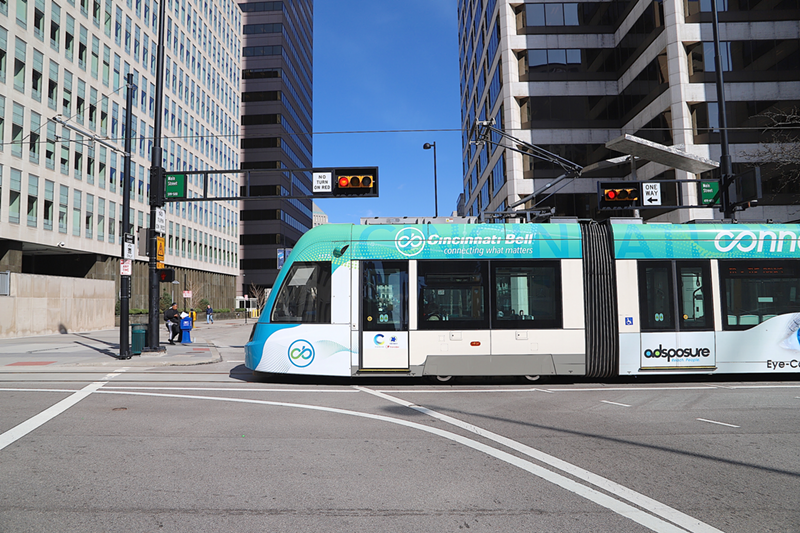Cincinnati's streetcar system faces a deficit as high as $1.36 million next fiscal year, according to the Southwest Ohio Regional Transit Authority, and the city says options for cutting costs are few and far between.
That means the city needs to bring in new revenue to support the 3.6-mile rail loop through Over-the-Rhine and downtown, city administration says in a report it presented to Cincinnati City Council's Budget and Finance Committee today.
But some council members questioned the city's numbers and assumptions. They wanted to know why the hiring of a city streetcar CEO hadn't reduced operating costs for the system and why the city has yet to install digital advertising kiosks that could bring in new revenue for the streetcars.
"There is significant revenue we're losing every day," Landsman said of the kiosks, which have already been purchased by the Southwest Ohio Regional Transit Authority but have not been placed by the city.
Council member Chris Seelbach also decried continued track blockages along the streetcar's routes, saying that a number of dynamics seemed to amount to "self-sabotage" when it came to the city and the streetcar.
"All of this is just dogging our system,"he said.
The city has come up with two scenarios to raise revenue that will fill the streetcar's budget gap:
1. End an exemption nonprofits receive for the city's event tickets tax, a move city administration says would raise an additional $1.5 million, taking care of the streetcar's current deficit. Organizations like the Cincinnati Zoo, the Cincinnati Symphony Orchestra and others would be impacted the most by that change.
2. The city could also institute a number of parking-related changes that would raise additional revenue. These include:
• A program starting January 2020 that would place boots on vehicles that have delinquent parking tickets, which is estimated to raise $500,000 a year.
• Raising the cost of OTR's residential parking permit program from $50 to $360 a year, which would raise another $150,000 a year.
• A $5 boost to parking fines to raise an extra $400,000 a year.
Any of those proposals would close the gap for now, according to the city's presentation, but wouldn't deal with a longer-term problem. Currently, the streetcar gets $900,000 every year for its operations from the Haile Foundation. Those payments are scheduled to cease in 2026.
The administration is suggesting doubling the contributions developers in downtown and Over-the-Rhine make under Voluntary Tax Incentive Contribution Agreements. With VTICA, developers receiving property tax cuts agree to contribute some of the money saved from the tax incentives to the streetcar's operating fund. Those 15 percent payments are expected to net the city about $324,000 next year — $16,000 less than initially projected. City administration says increasing VTICA to 30 percent would increase revenue by about $700,000 a year by 2026.
The city looked into cost-saving options, but found few places that could be cut and managed to trim just $200,000 from the budget.
"The city has exhausted its reasonable options to reduce expenditures and therefore cannot present a FY 2020 balanced budget within the existing resources," the city's presentation states.
Service reduction wouldn't save much money, city administration says. Cutting service by 20 percent would only slash about $128,000 a year from the cost of operating the streetcar, according to Transdev, the contractor who runs its day-to-day operations. And even cutting service in half would only save about $389,000 a year. Cutting service probably has other problems — those cuts would need to be approved by the Federal Transportation Administration because federal grants were used to fund a large part of the streetcar's construction.
In a separate memo released May 31, the city outlined costs for making the streetcar free to ride for a year. Supporters point to other systems without fares that have much higher ridership numbers than Cincinnati's streetcar. Kansas City's streetcar, for example, is free and gets more than 2 million riders a year compared to the 600,000 rides taken on Cincinnati's streetcar yearly.
The city says dropping fares would cost roughly $130,000-$170,000 a year.
After fare-related expenses are taken into account, the streetcar gets about $71,000 from riders a year, according to the city's data. In addition to losing that revenue, the city claims the streetcars would need extra security costing up to $100,000 a year if they were free to ride. The city's memo does not explain why extra security would be needed.
Cincinnati City Council took no action today on the budget deficit, but will consider options ahead of the end of the fiscal year June 30.






